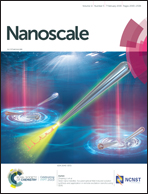Dynamics of amphiphilic block copolymers in an aqueous solution: direct imaging of micelle formation and nanoparticle encapsulation†
Abstract
Micelles formed through the aggregation of amphiphilic block copolymers are ideal drug nanocarriers. Despite their importance in nanomedicine, the detailed mechanisms through which micelles form and copolymers encapsulate the target nanomaterials are unclear. Here, using in situ liquid cell transmission electron microscopy imaging, we capture both the dynamics of micelle formation and their encapsulation of gold nanoparticles (NPs) in an aqueous solution. Our observations reveal that the amphiphilic block copolymers aggregate and rearrange to form a micelle with a hydrophobic and rigid core, surrounded by a corona of hydrophilic blocks that extend into the solution. These micelles are stable against coalescence, and once mature, they do not merge. We also show that the encapsulation of hydrophobic NPs is a self-limiting process, which occurs through gradual adsorption of block copolymers; the growth of a polymeric shell around the NPs, shielding them from water, ceases when the NPs are fully covered by the adsorbed copolymers. The insights from these observations are of fundamental importance for the design of biocompatible soft materials.



 Please wait while we load your content...
Please wait while we load your content...